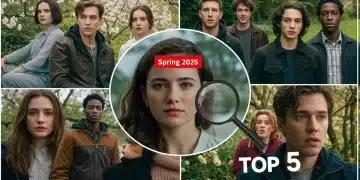Cable vs. Streaming: Which Delivers Better Originals in 2025?

Cable Originals vs. Streaming: Which Platform Offers Better Quality in 2025? This article explores the evolving landscape of original content, comparing the quality, production value, and viewer experience offered by cable networks and streaming services in 2025, helping you decide where to invest your viewing time.
The battle for original content supremacy is fiercer than ever. Cable Originals vs. Streaming: Which Platform Offers Better Quality in 2025? Let’s dive into the specifics.
The Shifting Sands of Television: Cable Adapts
Cable television, once the undisputed king of original programming, is now facing immense pressure from streaming services. To remain competitive in 2025, cable networks are adapting their strategies significantly.
Investing in High-Quality Productions
Cable channels recognize that captivating storytelling and strong production values are essential. They are focusing on fewer, but higher-quality, projects.
Focusing on Niche Audiences
Instead of trying to appeal to everyone, many cable networks are honing in on specific demographics with tailored content.
- Targeting specific age groups with nostalgic reboots and revivals.
- Creating content centered around hobbies and interests like cooking, home improvement, and travel.
- Developing shows that prioritize diversity and inclusivity.
The resilience of cable networks hinges on their ability to adapt and offer unique viewing experiences that streaming services might not prioritize.

The Rise of Streaming Giants: A New Era of Originals
Streaming services have revolutionized the television landscape, offering unparalleled accessibility and a vast library of content. In 2025, their dominance in original programming is undeniable.
Data-Driven Content Creation
Streaming platforms use viewer data to inform their content decisions, creating shows that are statistically more likely to succeed.
Global Reach and Diversity
Streaming services have massive international reach, allowing them to produce content in multiple languages and cater to diverse cultural tastes.
- Investing in local productions in various countries to resonate with regional audiences.
- Creating shows that feature underrepresented communities and perspectives.
- Collaborating with international talent to bring fresh and diverse stories to the forefront.
Streaming services are not just changing how we watch TV; they are fundamentally altering the types of stories being told and who gets to tell them.
Production Value Face-Off: Cable vs. Streaming
Production value is a key factor in the perceived quality of a television show. Both cable and streaming platforms are investing heavily in creating visually stunning and immersive experiences for their viewers.
Budgets and Visual Spectacle
Streaming services often have larger budgets to play with, enabling them to create visually impressive series with high-end special effects and elaborate sets.
Cinematic Storytelling
Both cable and streaming platforms are embracing cinematic storytelling techniques, blurring the lines between television and film.
- Using high-resolution cameras and professional-grade equipment to achieve a film-like aesthetic.
- Employing experienced cinematographers and directors with a background in film.
- Creating longer episodes that allow for more in-depth character development and complex plotlines.
The competition for visual excellence is driving both cable and streaming platforms to elevate the quality of their productions, resulting in a richer viewing experience for audiences.

Viewer Experience: Convenience and Accessibility
Besides the content itself, the viewing experience plays a crucial role in determining which platform offers better quality in 2025. Streaming services have a clear advantage in terms of convenience and accessibility.
On-Demand Viewing
Streaming services allow viewers to watch shows whenever and wherever they want, without being tied to a specific broadcast schedule.
Personalized Recommendations
Streaming platforms use algorithms to suggest shows based on viewing history, creating a more personalized and engaging experience.
- Offering curated playlists and collections based on genre, mood, and trending topics.
- Providing detailed information about each show, including synopses, cast lists, and user reviews.
- Allowing viewers to create multiple profiles within a single account, enabling personalized recommendations for each family member.
On the other hand, cable networks are exploring ways to enhance their on-demand offerings and improve the overall viewer experience, such as launching their own streaming apps and partnering with streaming services.
The Content Landscape in 2025: Predictions and Trends
Looking ahead to 2025, several key trends are shaping the content landscape, influencing the strategies of both cable and streaming platforms.
The Rise of Interactive Storytelling
Interactive storytelling is becoming increasingly popular, allowing viewers to make choices that influence the plot and outcome of a show.
The Blurring Lines Between Platforms
Cable networks and streaming services are increasingly partnering and collaborating, offering bundled packages and cross-platform content.
- Cable companies are offering streaming services as part of their cable packages.
- Streaming services are licensing content from cable networks to expand their libraries.
- Cable and streaming platforms are co-producing original series, sharing the costs and risks.
As the content landscape continues to evolve, the lines between cable and streaming platforms are becoming increasingly blurred, creating new opportunities and challenges for both.
Future of Original Television: Finding What Resonates
The future of original television depends on the ability of both cable and streaming platforms to adapt to changing viewer preferences and technological advancements. Finding what resonates with audiences, regardless of the platform, is the ultimate key to success.
Prioritizing Storytelling
Regardless of the platform, compelling storytelling will always be the most important factor in the success of a television show.
Investing in Talent
Hiring talented writers, directors, and actors is crucial for creating high-quality original content that resonates with audiences.
- Creating inclusive and diverse writing rooms to bring fresh perspectives and stories to the forefront.
- Providing opportunities for up-and-coming directors and filmmakers to showcase their talents.
- Offering mentorship programs and workshops to nurture the next generation of storytellers.
Ultimately, the platform that can consistently deliver compelling stories, regardless of the medium, will be the one that prevails in the battle for original content supremacy in 2025 and beyond.
| Key Aspect | Brief Description |
|---|---|
| 🎬 Original Content | Cable and streaming platforms invest heavily in original series. |
| 💰 Production Value | Streaming services often have larger budgets for higher visual quality. |
| 📱 Viewer Experience | Streaming offers on-demand viewing and personalized recommendations. |
| 🌐 Future Trends | Interactive storytelling and platform collaborations are on the rise. |
FAQ
▼
Yes, while facing competition, cable originals maintain strong niches. They focus on high-quality productions and target specific demographics to stay relevant.
▼
Streaming services often have larger budgets, leading to visually impressive shows with high-end effects and cinematic storytelling. However, cable is catching up.
▼
Streaming platforms provide on-demand viewing, personalized recommendations, and accessibility across multiple devices. This convenience is a major draw for viewers.
▼
Both cable and streaming are adapting by collaborating and incorporating interactive storytelling. These changes aim to enhance viewer engagement and adapt to preferences.
▼
The “better” platform depends on individual preferences. Streaming excels in convenience, while cable focuses on niche high-quality content. It’s a matter of viewer taste.
Conclusion
In the landscape of 2025, the choice between cable originals and streaming services depends on individual preferences. While streaming offers convenience and broad selection, cable continues to provide high-quality, niche content, catering to specific interests and demographics. The future likely holds a blend of both, with collaborations and innovative storytelling shaping the television landscape.





